#Citrus Pectin
Explore tagged Tumblr posts
Text
Global Citrus Pectin Market Is Estimated To Witness High Growth Owing To Increasing Demand for Natural Food Additives

The global Citrus Pectin Market is estimated to be valued at US$ 580.6 million in 2021 and is expected to exhibit a CAGR of 6.6% over the forecast period 2022-2030, as highlighted in a new report published by Coherent Market Insights. Market Overview: Citrus pectin is a natural food additive derived from the peels of citrus fruits such as oranges, lemons, and grapefruits. It is used as a gelling agent, stabilizer, and thickener in various food and beverage products. Citrus pectin has numerous advantages, including its ability to enhance the texture and viscosity of food products, improve mouthfeel, and extend shelf life. It is also a popular choice among consumers looking for natural and clean label ingredients in their food. Market Key Trends: One key trend in the global citrus pectin market is the increasing demand for natural food additives. With growing health consciousness among consumers, there is a rising preference for natural and organic ingredients in food and beverages. Citrus pectin offers a natural alternative to synthetic additives and is considered safe for consumption. The clean label trend has become a significant factor driving the demand for citrus pectin in the food industry. For example, in the bakery sector, citrus pectin is used as a gelling agent in fruit fillings and glazes. It provides a smooth texture and improves the mouthfeel of bakery products. Additionally, citrus pectin is used in dairy products, such as yogurt and ice cream, to enhance the stability and texture. PEST Analysis: Political: The political factors affecting the citrus pectin market include government regulations and policies regarding food additives. Stringent regulations on food safety and labeling requirements might impact the market. Economic: The economic factors influencing the citrus pectin market are the disposable income and purchasing power of consumers. Increasing per capita income in developing countries is driving the demand for premium food and beverage products. Social: The social factors include the changing consumer preferences and dietary patterns. The rising awareness about health and wellness has led to the adoption of natural and clean label products, which are driving the demand for citrus pectin. Technological: The technological factors impacting the citrus pectin market include advancements in extraction and purification methods. Technological innovations have helped in improving the yield and quality of citrus pectin. Key Takeaways: The global citrus pectin market is expected to witness high growth, exhibiting a CAGR of 6.6% over the forecast period, due to increasing demand for natural food additives. Consumers' preference for clean label ingredients and the rising awareness about health and wellness are driving the market growth. In terms of regional analysis, North America is expected to be the fastest-growing and dominating region in the citrus pectin market. The increasing demand for natural ingredients and clean label products in the food and beverage industry is fueling the market growth in this region. Key players operating in the global Citrus Pectin Market Analysis are Herbstreith & Fox GmbH, Cargill Inc., CP Kelco, DSM Andre Pectin, Silvateam S.p.A, DuPont de Nemoursm Inc., Naturex A.G., Compañía Española de Algas Marinas S.A. (CEAMSA), and Krishna Pectins Pvt. Ltd. These players are focusing on product development, expanding their distribution networks, and strategic partnerships to gain a competitive edge in the market. In conclusion, the global citrus pectin market is experiencing significant growth due to the increasing demand for natural food additives. Consumers' preference for clean label products and the rising awareness about health and wellness are expected to drive the market further. North America is expected to be the fastest-growing region, and key players are implementing various strategies to capture a larger market share.
#Citrus Pectin#Citrus Pectin Market#Citrus Pectin Market Size#Citrus Pectin Market Scope#Citrus Pectin Market Growth#Food and Beverages
0 notes
Text
Citrus Pectin Market Trends: Rising Demand, Key Innovations, and Future Growth Prospects
The citrus pectin market is experiencing significant growth, driven by increasing demand for natural and functional ingredients across the food, pharmaceutical, and cosmetic industries. Pectin, a natural fiber derived from citrus peels, is widely used as a gelling agent, stabilizer, and fat replacer in various applications. With rising consumer preference for clean-label products, the demand for citrus pectin has surged, fostering innovation in processing techniques and sustainable sourcing methods. This article explores key trends, market drivers, and future opportunities shaping the citrus pectin market.

Rising Demand for Natural and Clean-Label Ingredients
The growing awareness of health and wellness has led consumers to seek natural, plant-based ingredients in food and beverage formulations. Citrus pectin, known for its functional properties and natural origin, aligns with this shift toward clean-label products. Food manufacturers are increasingly incorporating pectin in dairy alternatives, fruit-based products, and low-sugar formulations to enhance texture and stability. Additionally, the demand for organic and non-GMO pectin variants has increased, further driving market expansion.
Expanding Applications in Pharmaceuticals and Cosmetics
Beyond the food industry, citrus pectin is gaining traction in pharmaceuticals and cosmetics. In the pharmaceutical sector, it is used for its prebiotic benefits, aiding gut health and digestive regulation. Research has also highlighted its potential in cancer treatment and cholesterol reduction. In the cosmetics industry, pectin is utilized in skincare formulations for its hydrating and emulsifying properties, contributing to the development of eco-friendly and plant-based beauty products. The rising preference for sustainable and biodegradable ingredients in personal care further boosts its demand.
Technological Advancements and Sustainable Processing
Advancements in extraction and processing techniques have enhanced the efficiency and sustainability of citrus pectin production. Companies are exploring eco-friendly extraction methods that reduce chemical usage and optimize yield. Enzymatic extraction and microwave-assisted processes are among the innovations improving purity and functionality. Additionally, sustainable sourcing practices, including the utilization of citrus peel waste from juice production, are reinforcing the industry’s commitment to circular economy principles.
Regional Market Trends and Growth Opportunities
The citrus pectin market is expanding across key regions, with Europe and North America leading in demand due to stringent regulations favoring natural ingredients. The Asia-Pacific region is emerging as a lucrative market, driven by rapid urbanization, increasing disposable incomes, and growing consumer awareness of functional food products. Latin America, with its abundant citrus production, is a significant supplier of raw materials, contributing to the global supply chain. Investments in local processing units and collaborations with citrus growers are strengthening market growth in these regions.
Future Outlook and Market Challenges
The future of the citrus pectin market looks promising, with ongoing research and product innovation driving its application in diverse sectors. However, challenges such as fluctuating raw material prices, supply chain disruptions, and competition from alternative gelling agents remain concerns for industry players. Companies investing in sustainable practices, diversification, and advanced processing technologies will likely gain a competitive edge in the evolving market landscape.
Conclusion
The citrus pectin market is witnessing dynamic growth, fueled by consumer preference for natural ingredients, expanding applications, and advancements in sustainable processing. With increasing regulatory support and evolving consumer trends, the market is set for continued expansion. Industry players focusing on innovation and eco-friendly sourcing will play a pivotal role in shaping the future of citrus pectin applications worldwide.
0 notes
Text
Citrus Pectin Market Dynamics: Insights and Analysis

The citrus pectin market is primarily dominated by products derived from oranges and lemons owing to their abundancy and cost-effectiveness. Citrus pectin finds wide applications in food & beverages, pharmaceuticals, and personal care products due to its gelling, thickening, and stabilizing properties. It helps reduce calories and sugar content in various products.
The Global Citrus Pectin Market is estimated to be valued at US$ 580.6 Mn in 2024 and is expected to exhibit a CAGR of 6.6% over the forecast period 2023 to 2030. Key Takeaways Key players operating in the citrus pectin market are Herbstreith & Fox GmbH, Cargill Inc., CP Kelco, DSM Andre Pectin, Silvateam S.p.A, DuPont de Nemoursm Inc., Naturex A.G., Compañía Española de Algas Marinas S.A. (CEAMSA), and Krishna Pectins Pvt. Ltd. These players are focusing on new product development and expansion strategies to strengthen their market position. The growing demand for low-calorie and sugar-free food and beverage products is driving the citrus pectin market. Citrus pectin is widely used as a thickening agent and stabilizer in various low-calorie food varieties. The increasing health consciousness among people is further propelling the product demand. The citrus pectin market is expanding globally due to the growing food processing industry. Major players are focusing on tapping opportunities in emerging economies of Asia Pacific and Latin America. Rising disposable incomes and changing lifestyles are expected to boost the demand for processed food products containing citrus pectin in developing regions. Market key trends One of the key trends spurring growth in the citrus pectin market is the increasing demand for multi-functional and clean-label ingredients. Citrus pectin offers several functional benefits and is naturally sourced, which appeals to health-conscious consumers. Players are developing innovative citrus pectin variants with added benefits for various industries. Furthermore, citrus pectin is witnessing widening applications as a gelling agent and stabilizer in industries like personal care, pharmaceuticals, and biomedical. New product launches incorporating citrus pectin according to evolving industry and regulatory standards will present lucrative prospects.
Porter’s Analysis Threat of new entrants: Difficult for new players to enter market as it requires huge capital investments and R&D for pectin extraction from citrus fruits. Established players enjoy economies of scale. Bargaining power of buyers: Buyers have moderate bargaining power due to availability of substitutes. However, citrus pectin has unique applications not offered by substitutes. Bargaining power of suppliers: Suppliers of raw materials like citrus fruits have low bargaining power due to abundant supply globally. Suppliers are price takers. Threat of new substitutes: Substitutes like apple pectin, potato starch exist but have narrow applications versus versatile citrus pectin. Switching costs are high for end users. Competitive rivalry: Intense competition among existing multinational players. Product differentiation and expansion to new applications and regions is the focus. Geographical Regions
North America holds the largest share in terms of value currently due to high demand from food & beverages industry in USA and Canada. Strong presence of leading players also contributes to regional dominance. Asia Pacific is expected to be the fastest growing region during forecast period due to rising citrus fruit cultivation and increasing use of citrus pectin as gelling agent and stabilizer in processed food sector of India and China. Growing health consciousness is propelling demand.
0 notes
Text
Unlocking the Potential of Citrus Pectin: Market Analysis and Applications
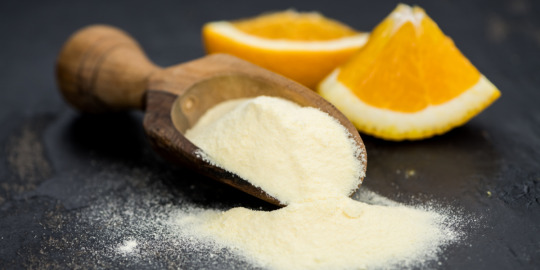
Citrus Pectin Market is expanding rapidly driven by rising health awareness The Citrus Pectin Market comprises products extracted from the peel or pulp of citrus fruits such as lemon, orange and lime. Citrus pectin is a hydrocolloid derived from citrus fruit waste like peels and possesses gelling, thickening and stabilizing properties. It is used extensively as a gelling and thickening agent by food industries in products like jams, jellies, fruit spreads, dairy, bakery and confectionery items. Citrus pectin aids in texture enhancement and binding qualities while improving nutritional profiles. It is favored for low calorie content yet provides bulk and fiber. Citrus pectin also benefits digestive health by promoting gut microbial diversity and regular bowel movements. The Global Citrus Pectin Market is estimated to be valued at US$ 580.6 Mn in 2024 and is expected to exhibit a CAGR of 6.6% over the forecast period 2023 to 2030. Key Takeaways Key players operating in the Citrus Pectin market are Herbstreith & Fox GmbH, Cargill Inc., CP Kelco, DSM Andre Pectin, Silvateam S.p.A, DuPont de Nemoursm Inc., Naturex A.G., Compañía Española de Algas Marinas S.A. (CEAMSA), and Krishna Pectins Pvt. Ltd. The growing demand for health and wellness products is fueling the Citrus Pectin market. Citrus pectin is gaining popularity as a digestive health enhancer and prebiotic dietary fiber. It finds applications in various functional foods and supplements. Citrus Pectin market is expanding globally with growth in emerging economies of Asia Pacific and Latin America. Rising health awareness and improving economic conditions are encouraging consumption of nutritional foods using ingredients like citrus pectin. Market Key Trends Demand for clean label and natural ingredients is a key trend in the food industry. Citrus Pectin being a natural hydrocolloid extracted from citrus peel waste without chemical modifications, fits well with the clean label concept. Growing consumer preference for natural ingredients over artificial or synthetic additives is creating opportunities for citrus pectin. The possibility of citrus pectin to control calories while providing textures is also driving its use in weight management functional food products.
Porter's Analysis Threat of new entrants: New entrants may face higher costs related to establishing brand awareness, manufacturing facilities and distribution channels. Bargaining power of buyers: Buyers have moderate bargaining due to availability of substitutes. Bargaining power of suppliers: Suppliers have moderate bargaining power due to availability of substitute raw materials. Threat of new substitutes: Substitute products like guar gum, xanthan gum and agar act as competitive substitutes. Competitive rivalry: The market is highly competitive due to presence of major global players. Geographical Regions The citrus pectin market in North America accounts for the largest share of around 30% of the global market in terms of value. This can be attributed to increasing demand for natural and plant-based food ingredients in the region. The citrus pectin market in Asia Pacific is expected to witness the fastest CAGR of around 7.4% during the forecast period. Rising health consciousness among consumers as well as growing food processing industries in countries like China and India are driving market growth in the region.
0 notes
Text
Citrus Pectin Market Symphony: Harmonizing Taste and Texture in Modern Cuisine
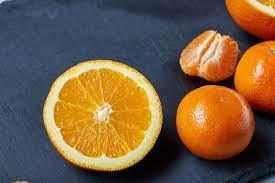
Citrus pectin is a dietary fiber extracted from citrus fruits, primarily lemons and oranges. It is considered as an important food additive due to its thickening and gelling properties. Citrus pectin helps increase the viscosity of products and binds water molecules. It is used as a stabilizer and a thickening agent in food and pharmaceutical products. The global demand for processed foods and beverages is increasing rapidly owing to changing lifestyles and urbanization. Food processing industries are extensively using citrus pectin as a stabilizing agent and gelling agent for products such as jams, jellies, syrups, fruit juices, bakery products, and dairy products. The global citrus pectin market is estimated to be valued at US$ 580.6 million in 2024 and is expected to exhibit a CAGR of 6.6% over the forecast period 2023 to 2030, as highlighted in a new report published by Coherent Market Insights. Market Opportunity: The increased applications of citrus pectin in functional foods will present lucrative growth opportunities for the citrus pectin market. Pectin from citrus fruits is considered a functional fiber and has various health benefits such as lowering cholesterol, controlling blood sugar levels, and improving digestive functions. Due to these properties, citrus pectin is increasingly being used in various functional foods such as dietary supplements, breakfast cereals, health drinks, and yogurts. The rising demand for natural and high-fiber foods among consumers is driving food manufacturers to incorporate more citrus pectin in functional food products. The expansion of functional foods categories worldwide will continue to propel the demand for citrus pectin in the coming years. Porter's Analysis Threat of new entrants: The threat of new entrants is moderate as citrus pectin manufacturing requires specialized equipment and technical expertise. Established brands have significant brand recognition and customer loyalty. Bargaining power of buyers: The bargaining power of buyers is high as citrus pectin is used as an ingredient in various food products. Buyers can find substitutes or alternatives easily if pricing is not competitive. Bargaining power of suppliers: The bargaining power of suppliers is moderate. While citrus fruits are agricultural commodities, a few large suppliers exist. Threat of new substitutes: The threat of new substitutes is high as guar gum, xanthan gum, and other hydrocolloids can replace citrus pectin in many applications. Competitive rivalry: The competitive rivalry is high owing to the presence of numerous regional and global players. Companies compete on pricing, product quality, and customer service. SWOT Analysis Strengths: Citrus pectin is a natural ingredient derived from citrus peel. It has functional properties like gelling, thickening, and stabilization. It is widely used in various food applications. Weaknesses: Citrus pectin production depends on citrus fruit cultivation. Supply can fluctuate depending on weather conditions. The properties of citrus pectin are pH and sugar dependent. Opportunities: Growing demand for clean label and natural ingredients in food products present an opportunity. Expanding citrus fruit cultivation in new geographies could support supply. Developing modified and low-methoxy pectins can widen applications. Threats: Stringent food safety and labeling regulations increase compliance costs. Price fluctuations in raw materials impact profit margins. Alternate hydrocolloids threaten substitution. Key Takeaways The global citrus pectin market is expected to witness high growth over the forecast period of 2023 to 2030 supported by rising demand for natural food ingredients.
Regional analysis: Asia Pacific is projected to be the fastest growing region in the citrus pectin market during the forecast period. Countries like China, India, Thailand, and Indonesia offer opportunities for citrus cultivation as raw material and market expansion. Growth will be driven by rising health awareness, westernization of diets, and expanding food manufacturing industries. Key players: Key players operating in the citrus pectin market are CP Kelco, DowDuPont, Cargill, Herbstreith & Fox, Andre Group, Silvateam, Naturex, and Krishna Pectins. Companies are investing in R&D and production capacity expansion to strengthen their market position.
#Citrus Pectin Market Share#Citrus Pectin Market Growth#Citrus Pectin Market Demand#Citrus Pectin Market Trend#Citrus Pectin Market Analysis
0 notes
Text
Citrus Pectin Market Analysis And Demand With Forecast Overview To 2030

The global citrus pectin market is set to experience substantial growth, with a projected Compound Annual Growth Rate (CAGR) ranging between 5.2% and 8.27% from 2023 to 2030. By the end of this forecast period, the market is expected to reach a size of US$ 1696.9 million to US$ 1995.34 million.
Citrus pectin, commonly known as modified citrus pectin (MCP), is a highly versatile substance derived from the peels, seeds, and pulp of citrus fruits, notably lemons, oranges, and grapefruits. This modified form of pectin, a naturally occurring polysaccharide found in various fruits and vegetables, holds significant potential across diverse industries.
Request A Report Sample To Gain Comprehensive Insights@ https://www.absolutemarketresearch.com/Global-Citrus-Pectin-Market/2536/request-sample
The projected growth of the global citrus pectin market reflects the increasing recognition of its multifaceted applications. As a natural polysaccharide, citrus pectin is known for its ability to modify and improve the texture, stability, and consistency of food products. This has led to its widespread use in the food and beverage industry as a gelling agent, thickener, and stabilizer.
Moreover, citrus pectin has garnered attention for its potential health benefits. Research suggests that modified citrus pectin may have various health-promoting properties, including immune system support and potential anti-cancer effects. As consumer awareness regarding the health benefits of natural ingredients continues to rise, the demand for citrus pectin is expected to see a significant upswing.
Drivers of the Citrus Pectin Boom:
Health & Wellness Craze: Consumers are increasingly seeking natural, functional ingredients, and citrus pectin fits the bill perfectly. Its cholesterol-lowering properties, digestive benefits, and potential role in cancer prevention are making it a star in health-conscious kitchens.
Food & Beverage Boom: The global food and beverage industry is bursting with innovation, and citrus pectin is a versatile tool for food scientists. It thickens jams, jellies, and desserts, stabilizes beverages, and adds a clean, citrusy flavor, making it a go-to for manufacturers.
Pharmaceutical & Cosmetic Applications: Citrus pectin's gelling and thickening properties are not just for food. It finds use in pharmaceuticals as a binder and lubricant in tablets and capsules, and in cosmetics as a thickening agent and moisturizer.
Rising Demand for Sustainability: Citrus peels, once a waste product, are now a valuable source of pectin. This sustainable extraction process resonates with environmentally conscious consumers and businesses, further propelling the market.
Market Trends to Savor:
High Methoxyl Pectin Takes the Lead: This type of pectin, with its superior gelling and thickening power, is expected to dominate the market, driven by its use in jams, jellies, and confections.
Regional Variations: While Europe and North America currently hold the largest market shares, Asia Pacific is projected to be the fastest-growing region, fueled by rising disposable incomes and a booming health food market.
Innovation & Technology: Advancements in extraction and purification techniques are leading to higher-quality pectin with improved functionality and flavor, opening up new application avenues.
Key Takeaways:
The global citrus pectin market is expected to grow at a CAGR of 5.2% to 8.27% between 2023 and 2030, reaching a size of US$ 1696.9 million to US$ 1995.34 million by the end of the forecast period.
Rising demand for clean-label food products and increasing awareness of the health benefits of citrus pectin are key drivers of market growth.
High methoxyl pectin is the dominant segment due to its superior thickening and gelling properties, but low methoxyl pectin is gaining traction due to its affordability.
The food and beverages industry is the largest consumer of citrus pectin, followed by the pharmaceuticals and cosmetics industries.
Europe and North America are the largest regional markets, but Asia Pacific is expected to be the fastest-growing region due to rising disposable income and increasing urbanization.
Regional Outlook:
Europe: Dominates the market due to established food and beverage industries and high consumer preference for natural ingredients.
North America: Second largest market, driven by demand for healthy and convenient food options.
Asia Pacific: Fastest-growing region due to rising disposable income and increasing demand for processed foods.
Latin America: Steady growth expected, driven by growing middle class and increasing awareness of citrus pectin's health benefits.
Middle East and Africa: Smaller market with slower growth, but potential for expansion in the future.
Key Players:
CP Kelco (US)
Herbstreith & Fox (Germany)
Cargill (US)
Yantai Jinhe Pectin Co. Ltd. (China)
Nature's Best (US)
SunSweet Citrus Products Inc. (US)
China National Pectin Co., Ltd. (China)
FMC BioPolymer (US)
Südzucker AG (Germany)
EID Parry (India)
Segmentation:
By Type:
High Methoxyl Pectin (HMP)
Low Methoxyl Pectin (LMP)
Amidated Pectin
By Application:
Food & Beverages
Pharmaceuticals
Cosmetics & Personal Care
Others (e.g., textiles, animal feed)
By Region:
Europe
North America
Asia Pacific
Latin America
Middle East & Africa
0 notes
Text
Citrus Pectin Market Boosting the Growth Worldwide: Market Dynamics and Trends, Efficiencies Forecast 2033
The global citrus pectin market is anticipated to reach a valuation of US$ 122,277.4 million in 2023, driven by clean-label and plant-based trends. This trend is expected to create new opportunities for the global market, leading to a projected CAGR of 4.8% between 2023 and 2033. It is estimated to gain a valuation of approximately US$ 191,678.9 million by 2033.
Pectin is mainly used in sweets such as jellies, jams, and marmalade. Industry players have developed pectin suitable for various purposes as technology has evolved. For example, GENU Pectin by CP Kelco is gaining prominence in the personal care and cosmetics industries as an organic skin feel stabilizer, assist, and pH-balancing component.
Request Sample Report and Drive Impactful Decisions: https://www.futuremarketinsights.com/reports/sample/rep-gb-11039
Citrus pectin, when utilized as an ingredient in such products, may be a healthy choice that promotes growth. A growing number of diet-conscious clients are looking for ways to cut fat and calories. Citrus pectin-induced meals are an excellent choice for this demographic. The increasing need for citrus pectin within the baking and confectionery sectors is expected to drive market growth during the forecast period. Pectin is used as a fat or sugar alternative in low-calorie recipes and bakery preserves.
Citrus pectin is in high demand in the confectionery industry because it provides jellies and jams with a gel-like consistency while imparting a pleasant taste to the meals. Citrus pectin can improve confectionary foods’ texture, color, and shelf life.
Key Takeaways from the Market Study
Historically, the citrus pectin market increased at a CAGR of 4% from 2018 to 2022.
The United States is expected to take over 23.7% of the citrus pectin market in 2023.
China is expected to control 12.1% of the global citrus pectin market by 2023.
By 2023, Japan’s citrus pectin market will account for 4.5% of the worldwide market.
The citrus pectin market in France is expected to grow by 5.3% by 2023.
The citrus pectin market in the United Kingdom is predicted to grow to 5.8% by 2023.
High-methoxyl pectin accounts for more than half of the worldwide citrus pectin market.
The grapefruit category is expected to grow at an 8.4% CAGR during the next ten years to come.
“The market will see growth during the projected period owing to the rising consumer preferences towards clean-label, plant-based, organic and vegan food products,” says Nandini Roy Choudhury, Client Partner at Future Market Insights. .
Competitive Landscape
Prominent players in the citrus pectin market are:
Fiber Star
Cargill, Inc.
DuPont
Ceamsa
Naturex, SA
CP Kelco
Yantai Andre Pactin Co. Ltd.
Herbstreith & Fox KG Pektin-Fabriken
Herbafood Ingredients GmbH
Silvateam S.pa.
Florida Food Products, Inc.
Lucid Colloids Ltd.
Product Portfolio
Under the GENU® brand, CP Kelco sells a number of pectin products, particularly citrus pectin. These pectins are found in a variety of food and beverage applications, such as dairy products, fruit spreads, and bread goods.
CitriTex® citrus pectin products from Cargill are developed for gelling as well as thickening uses in the food and beverage industries. It is well-known for its gelling qualities and is utilized in jellies, jams, and fruit preparations.
Citrus pectin products from DuPont’s GRINDSTED® pectin line are appropriate for a variety of culinary applications. These pectins are used to gel and stabilize goods like fruit spreads, dairy treats, and confectionery products.
Request for our Comprehensive Research Methodology to Understand the Market: https://www.futuremarketinsights.com/request-report-methodology/rep-gb-11039
More Valuable Insights Available
Future Market Insights offers an unbiased analysis of the global citrus pectin market, providing historical data for 2018 to 2022 and forecast statistics from 2023 to 2033.
To understand opportunities in the citrus pectin market, the market is segmented on the basis of product type (high methoxyl pectin, low methoxyl pectin), source (oranges, tangerines/ mandarins, grapefruit, lemon and lime), application (jams & jellies, beverages, bakery fillings & toppings, dairy products & frozen desserts, confectionery, meat & poultry, dietary supplements, functional food, pharmaceutical, personal care & cosmetics, others), and across seven major regions (North America, Latin America, Western Europe, Eastern Europe, South Asia & Pacific, East Asia, and Middle East & Africa).
Segmentation Analysis of the Citrus Pectin Market
By Product Type:
High Methoxyl Pectin
Low Methoxyl Pectin
By Source:
Oranges
Tangerines/Mandarins
Grapefruit
Lemon and Lime
By Application:
Jams & Jellies
Beverages
Bakery Fillings & Toppings
Dairy Products & Frozen Desserts
Confectionery
Meat & Poultry
Dietary Supplements
Functional Food
Pharmaceutical
Personal Care & Cosmetics
Others
By Region:
North America
Latin America
Western Europe
Eastern Europe
South Asia and Pacific
East Asia
The Middle East & Africa
Information Source: https://www.futuremarketinsights.com/reports/citrus-pectin-market
0 notes
Text
Foods You Can Eat Instead of Taking Vitamins and Supplements 🍎🥥🥦🥑🍌
Vitamin A: Carrots, sweet potatoes, spinach, kale.
B Vitamins: Whole grains, meat, eggs, nuts, legumes.
Vitamin B1 (Thiamine): Whole grains, legumes, nuts, pork, fortified cereals.
Vitamin B2 (Riboflavin): Dairy products, lean meats, almonds, leafy greens. Vitamin B3 (Niacin): Poultry, fish, nuts, legumes, whole grains.
Vitamin B5 (Pantothenic Acid): Meat, poultry, eggs, avocado, whole grains.
B6: Chicken, turkey, fish, bananas, chickpeas.
Folate (Vitamin B9): Leafy greens, legumes, citrus fruits, fortified grains.
Vitamin B12: Animal products (meat, fish, dairy), fortified plant-based foods.
Vitamin C: Citrus fruits, strawberries, bell peppers.
Vitamin D: Fatty fish (salmon, mackerel), fortified dairy products, sunlight.
Vitamin E: Sunflower seeds, almonds, vegetable oils, nuts, spinach, broccoli.
Vitamin F (Essential Fatty Acids): Fatty fish, flaxseeds, chia seeds, walnuts.
Vitamin H (Biotin): Eggs, nuts, sweet potatoes, salmon, avocado.
Vitamin K: Leafy greens (kale, spinach), broccoli, Brussels sprouts.
Vitamin K2: Fermented foods (natto, cheese), animal products, leafy greens.
Vitamin L1 (Anthranilic Acid): Cruciferous vegetables (cabbage, cauliflower), legumes.
Vitamin P (Bioflavonoids): Citrus fruits, berries, onions, green tea.
Vitamin Q (Ubiquinone): Fatty fish, organ meats, spinach, cauliflower.
Vitamin T (L-carnitine): Red meat, poultry, fish, dairy products.
Vitamin U (S-Methylmethionine): Cabbage, broccoli, Brussels sprouts.
Betaine: Beets, spinach, whole grains, seafood.
Boron: Fruits (apples, pears), legumes, nuts, avocado.
Calcium: Dairy products, leafy greens (kale, collard greens), almonds.
Carnosine: Beef, poultry, fish.
Carnitine: Red meat, dairy products, fish.
Catechins: Green tea, black tea, dark chocolate.
Choline: Eggs, liver, beef, broccoli, soybeans.
Creatine: Red meat, fish, poultry.
Chromium: Broccoli, whole grains, nuts, brewer's yeast.
Chondroitin: Cartilage-rich foods (bone broth, connective tissue of meat).
Copper: Shellfish, nuts, seeds, organ meats, lentils.
Coenzyme Q10 (CoQ10): Fatty fish, organ meats, nuts, soybean oil.
Ellagic Acid: Berries (strawberries, raspberries), pomegranates.
Glucosinolates: Cruciferous vegetables (cabbage, broccoli, cauliflower).
Glucosamine: Shellfish (shrimp, crab), bone broth, animal connective tissues.
Glutamine: Dairy products, meat, poultry, cabbage.
Inositol: Citrus fruits, beans, nuts, whole grains.
Iodine: Seafood, iodized salt, dairy products.
Iron: Red meat, poultry, beans, lentils, spinach.
L-Theanine: Mushrooms, black tea, white tea, guayusa.
Lignans: Flaxseeds, whole grains, cruciferous vegetables.
Lutein and Zeaxanthin: Leafy greens (spinach, kale), corn, eggs.
Lycopene: Tomatoes, watermelon, pink grapefruit.
Magnesium: Spinach, nuts, seeds, whole grains, beans.
Manganese: Nuts, seeds, whole grains, leafy greens, tea.
Melatonin: Cherries, grapes, tomatoes.
Omega-3 fatty acids: Flaxseeds, chia seeds, walnuts, fatty fish.
PABA (Para-Aminobenzoic Acid): Whole grains, eggs, organ meats.
Pantothenic Acid (Vitamin B5): Meat, poultry, fish, whole grains, avocado
Pectin: Apples, citrus fruits, berries, pears.
Phosphorus: Dairy products, meat, poultry, fish, nuts.
Prebiotics: Garlic, onions, leeks, asparagus, bananas (unripe), oats, apples, barley, flaxseeds, seaweed.
Probiotics: Yogurt, kefir, fermented foods (sauerkraut, kimchi).
Potassium: Bananas, oranges, potatoes, spinach, yogurt.
Polyphenols: Berries, dark chocolate, red wine, tea.
Quercetin: Apples, onions, berries, citrus fruits.
Resveratrol: Red grapes, red wine, berries, peanuts.
Rutin: Buckwheat, citrus fruits, figs, apples.
Selenium: Brazil nuts, seafood, poultry, eggs.
Silica: Whole grains, oats, brown rice, leafy greens.
Sulforaphane: Cruciferous vegetables (broccoli, Brussels sprouts), cabbage.
Taurine: Meat, seafood, dairy products.
Theanine: Green tea, black tea, certain mushrooms.
Tyrosine: Meat, fish, dairy products, nuts, seeds.
Vanadium: Mushrooms, shellfish, dill, parsley, black pepper.
Zeatin: Whole grains, legumes, nuts, seeds.
Zinc: Oysters, beef, poultry, beans, nuts, whole grains.
#women health#health and wellness#healthy diet#healthy living#healthy lifestyle#womens health#health#health tips#wellness#levelupjourney#dream girl guide#dream girl tips#dream girl journey#health is wealth#clean girl aesthetic#clean girl#it girl#nutrition#supplements#organic#food#nutrients#healthyhabits#healthy life tips#self love journey#self love#dream life#dream girl
2K notes
·
View notes
Video
youtube
The 3 Fruits You Need Daily To Detox Your Body
Detoxification is a crucial process that helps in the elimination of harmful toxins from our body, enhancing the overall health and well-being. The human body naturally detoxifies itself; however, certain foods can assist this process by providing the necessary nutrients and antioxidants. In this context, fruits play a pivotal role, offering a myriad of health benefits including detoxification. This article unveils three powerhouse fruits that can significantly aid in daily detoxification of body organs. Please visit https://youtube.com/@HealthDishes for more health tips. Unveiling Three Powerhouse Fruits for Daily Detoxification of Body Organs 1. **Apples** - "An apple a day keeps the doctor away," is a saying that holds a substantial amount of truth. Apples are rich in soluble fiber known as pectin, which aids in the removal of food additives and metals from your system. They also contain a fantastic assortment of antioxidants, including flavonoids and Vitamin C, which support liver function - a key organ for detoxification. 2. **Lemons** - This citrus fruit is a powerhouse of Vitamin C, a vital component that aids the body in producing glutathione, a liver compound that drives away toxins. Drinking lemon water every morning can help stimulate your liver, improving its ability to detoxify. 3. **Beetroots** - Although not traditionally categorized as a fruit, beetroot’s sweet taste and high sugar content qualify it as one. Beetroots are packed with a range of beneficial compounds like betaine, which helps the liver cells eliminate toxins, and pectin, a fiber that clears the toxins that have been removed from the liver so they don't reincorporate back into the body. #Detoxification, #HealthyLiving, #Fruits, #Apples, #Lemons, #Beetroots, #Health, #Wellness, #BodyDetox, #Antioxidants In conclusion, incorporating fruits like apples, lemons, and beetroots into your daily diet can significantly aid in the detoxification of body organs. These fruits not only provide vital nutrients and antioxidants but also stimulate the proper functioning of the liver, a crucial organ for detoxification. Remember, a healthy body is the key to a healthy life. So, make sure to include these powerhouse fruits in your daily diet and give your body the detox it needs.
7 notes
·
View notes
Text

Citrus waste converted to biopolymers using cavitation
The citrus industry generates a substantial amount of waste, primarily peels and seeds, which are often underutilized despite their rich cellulose and pectin content. Conventional pectin and cellulose extraction methods are energy-intensive and generate harmful by-products. However, a recent study introduces a novel, green approach using cavitation, a process that uses sound waves to create bubbles in liquid, offering a sustainable and efficient alternative. The research team applied both hydrodynamic and acoustic cavitation techniques to convert citrus waste into "CytroCell," a micronized cellulose, and "IntegroPectin," a highly bioactive pectin. This process, termed "CytroCav," requires only water and electricity, operates at room temperature, and is completed in a single step, making it an exemplary circular economy practice. The findings are published in the Journal of Bioresources and Bioproducts.
Read more.
#Materials Science#Science#Cavitation#Biopolymers#Biomaterials#Polymers#Waste#Materials processing#Bubbles#Cellulose
17 notes
·
View notes
Text
Ultimate Word Tournament!
Season 2
tęsknota (Polish) /tɛw̃skˈnɔ.ta/ the feeling of missing someone or something, yearning.
albedo (English) /ælˈbi.doʊ/ 1. (physics, meteorology, astronomy, optics) The fraction of incident light or radiation reflected by a surface or body, commonly expressed as a percentage. 2. (botany) The whitish inner portion of the rind of citrus fruits that is a source of pectin, commonly referred to as the pith. 3. (alchemy) One of the four major stages of the magnum opus, involving purification of the prima materia.
71 notes
·
View notes
Text
Orange you glad
Sometimes cooking is just cooking; sometimes it is a creative project. Now, I have plenty of fruit around here - sometimes way more than I can deal with - but I have had an urge to make orange jelly or marmalade for a long time. Most of my garden canning or preserving is done for this year. I should treat myself? To a little 'just-because' jelly project?
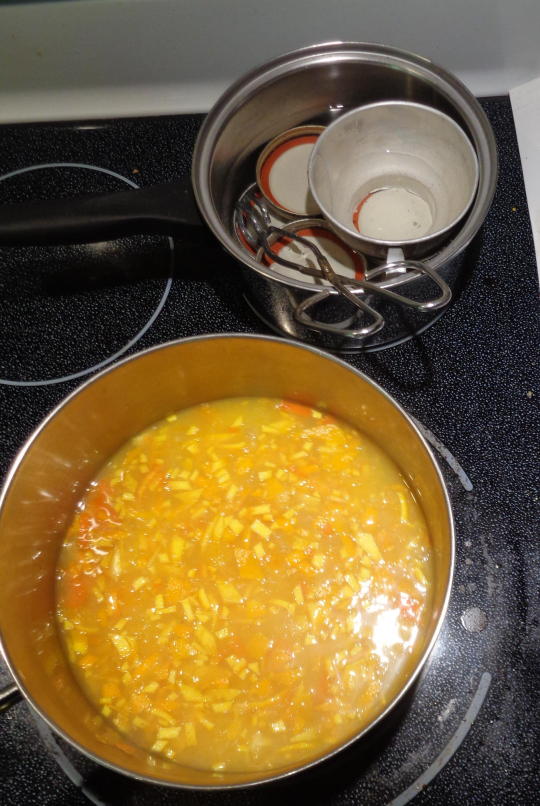
Do you know what 'supreming' a citrus fruit is? Cutting it up so you have all the membrane removed. It turns out that if you supreme a lemon, you will find tiny cuts and scrapes on your hands you had no idea you had. Ouch. Ouch! I zested and supremed one lemon, two tangerines, and two navel oranges. Then added enough oj to make 6 cups. Simmered that for 20 minutes (according to the recipe from Pomona's pectin). Most marmalade recipes are way, WAY more complicated than this one.
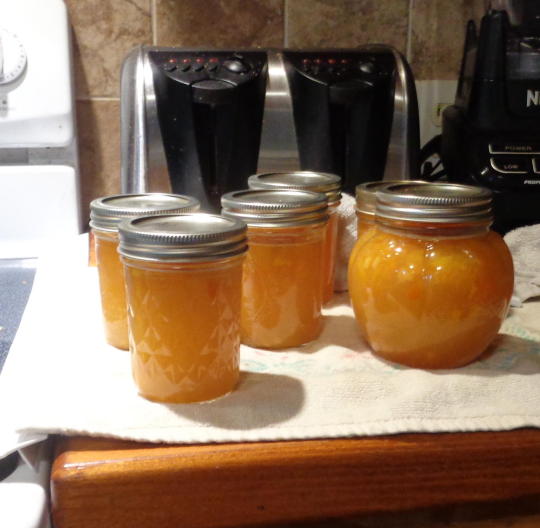
I bought that fun, odd-shaped pint canning jar at the farm supply store. They had four different shapes, and I loved them.
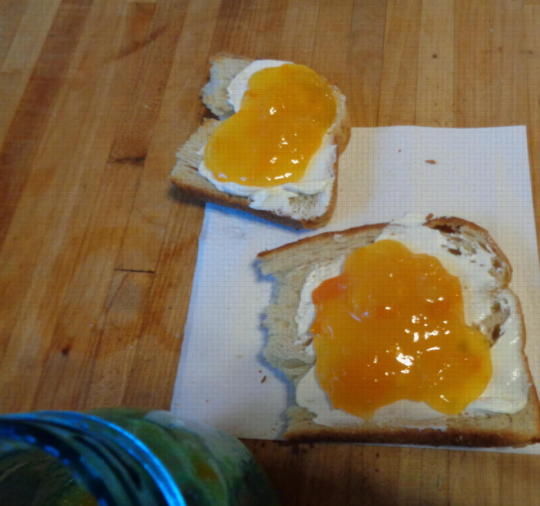
It takes longer to set than most jams, but I was willing to deal with my first serving being a little goopy. Guys. It is SO GOOD.
#oranges#preserves#jams#marmalade#farm kitchen#homemade#citrus#now I'm going to have to make it every year
21 notes
·
View notes
Text
Citrus Pectin Market Growth: Opportunities Ahead
Citrus Pectin Market is increasing consumption by food and beverages sector
Market overview: Citrus pectin is a high-molecular-weight polysaccharide substance obtained from the rinds of citrus fruits like oranges and lemons. It is widely used as a gelling agent and stabilizer in food products to increase their viscosity with a low-calorie count. Citrus pectin helps confer desirable texture and consistency to foods and beverages. It improves suspension properties, emulsion stability, and gel formation in various food items including jams, jellies, dairy products, confectionery, and beverages. The Global Citrus Pectin Market is estimated to be valued at US$ 580.6 Mn in 2024 and is expected to exhibit a CAGR of 6.6% over the forecast period 2023 to 2030. Key takeaways
Key players operating in the Citrus Pectin market are Herbstreith & Fox GmbH, Cargill Inc., CP Kelco, DSM Andre Pectin, Silvateam S.p.A, DuPont de Nemoursm Inc., Naturex A.G., Compañía Española de Algas Marinas S.A. (CEAMSA), and Krishna Pectins Pvt. Ltd. The increasing application of citrus pectin in various food industries like dairy, confectionery, and beverages is driving the market growth. The rising demand for convenience and functional food products is also propelling the consumption of citrus pectin. Most market players are focusing on expanding their production facilities globally to cater to the growing product demand from different countries. Market key trends
One of the key trends witnessed in the citrus pectin market is the introduction of innovative product formulations by various manufacturers. Citrus pectin is being employed to develop new types of gelling agents, stabilizing solutions, and texturizing ingredients for the food industry. Its unique gelling and thickening properties allow food companies to come up with novel textures and versatile formulations. Additionally, the rising demand for all-natural and clean label foods is increasing the utility of citrus pectin as it is procured from citrus fruits without any chemical additives. More market players are focusing on organic and non-GMO citrus pectin production to leverage on this trend.
Porter’s Analysis
Threat of new entrants: Low cost barriers and availability of raw materials has led to threat of new players entering the market and increasing competition. Bargaining power of buyers: Buyers have high bargaining power owing to availability of substitutes and undifferentiated nature of product. Bargaining power of suppliers: A few key companies control global supply of citrus pectin making suppliers have significant influence over pricing. Threat of new substitutes: Alternatives like gums, starches act as substitutes but citrus pectin is preferred for its functional properties in various applications. Competitive rivalry: Strong competition exists amongst existing players to cater growing demand and capture greater market share. Geographical Regions North America holds the largest market share presently due to high demand from food and beverage industry in the region. Rising health consciousness is driving consumption of functional foods utilizing citrus pectin. Asia Pacific is emerging as the fastest growing regional market backed by growing middle class population, rising disposable incomes and shifting diet patterns. China, India are demonstrating high growth potential country markets. Geographical Regions Europe currently accounts for significant value share led by Germany, France, UK. Established food processing industry and adoption of healthier lifestyle is sustaining demand. South America and Middle East too offer lucrative prospects fueled by increasing food processing activities and economy expansions underway in key nations like Brazil, Argentina, Turkey. Porter’s Analysis Threat of new entrants: Low barriers enables ease of market entry but scale and relationships give incumbents edge over newcomers. Bargaining power of buyers: Large buyers can negotiate lower prices but variety of uses maintains supplier bargaining power. Bargaining power of suppliers: Few suppliers exist but differentiation of supply chains caps influence over market leader pricing. Threat of new substitutes: Alternatives serve some needs but none completely replace citrus pectin functions across applications. Competitive rivalry: Leaders continually invest in technology & sourcing to improve quality and customer service retaining market share. Geographical Regions North America holds largest value share with U.S. as major consumer market. Growth stems from functional foods sector. Asia Pacific shows strongest gains led by China, India employing citrus pectin in burgeoning food processing industries catering rising incomes. Europe accounts for major portion with Germany, U.K., France at forefront of regional market. Functional ingrediants see mounting demand.
0 notes
Text
Sichuan Pepper Marmalade
Or: a surprisingly workable idea, executed poorly by an idiot
About a year ago, I made a post talking about how Sichuan pepper (henceforth: huajiao, English needs a shorter term) is a close relative of the citrus fruits and wondering if it can be used for some of the same things (and also if it can hybridize - seems like no)
This post documents my attempt to make marmalade using only huajiao, water and sugar (mostly to differentiate myself from other attempts)
tl;dr - I messed it up a bit, but I think someone more competent than me (possibly including me in the future) could make it work with minimal "cheating".
Long version under the cut
I revived this idea because I'd gotten my hands on some fresh huajiao:

pictured here along with why it's sometimes called "prickly ash", all the larger twigs have those thorns.
While stabbing myself only a little, I managed to separate the fruit from most of the twigs
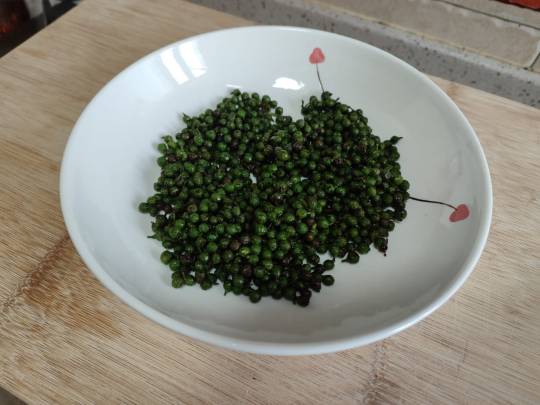
you might notice some of the fruit have shriveled a little, and others have gone black - fresh is a relative term, but this will be the least of my problems.
Most marmalade recipes call for the fruit to be sliced up thin (sometimes separating the pith and skin) to, among other things, help get the pectin out.
Does huajiao have any appreciable amount of pectin? Not a clue, but I decided to roughly chop about half of the huajiaos with a kitchen knife
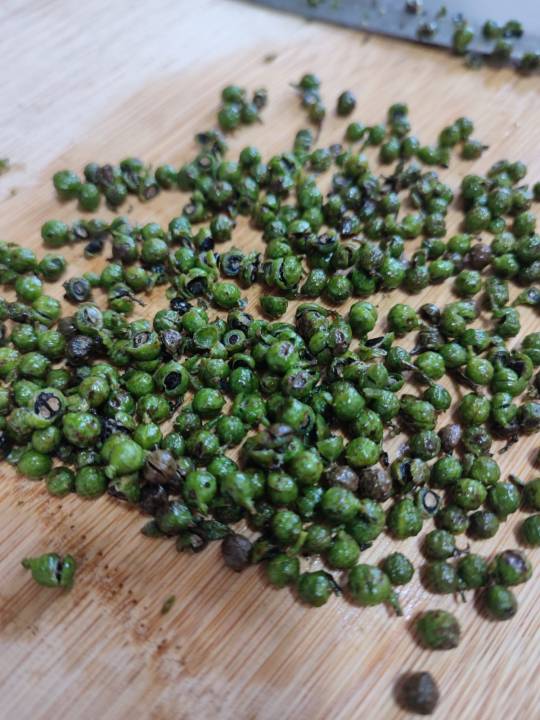
^like this
at this point, the relation to citrus fruit was very obvious, that chopped up mess above smelled more like limes than the dried huajiao I'm used to.
So I tipped this into a pot with some water and a 500g bag of sugar-First mistake: I used far too much water for the amount of fruit/sugar I had, so I ended up boiling this for ages, to the presumable detriment of the taste.
-the water initially turned faintly green (and dipping my finger in, tasted extremely strongly of huajiao) but soon began to become more of a yellow-brown colour.
During the initial stages of boiling there was another distinctly citrusy smell - this one more like pommelo/grapefruit than anything else - but unfortunately that faded before the liquid had reduced enough.
As mentioned I'd used too much water, and was also worried that the huajiao would take time to release whatever little pectin it had, so I left this boiling for quite some time, until the volume had reduced significantly and it had spent a few minutes boiling in a way that didn't look like pure water (Second mistake: I'm pretty sure I slightly burned the sugar doing this) - by the end, it looked like this
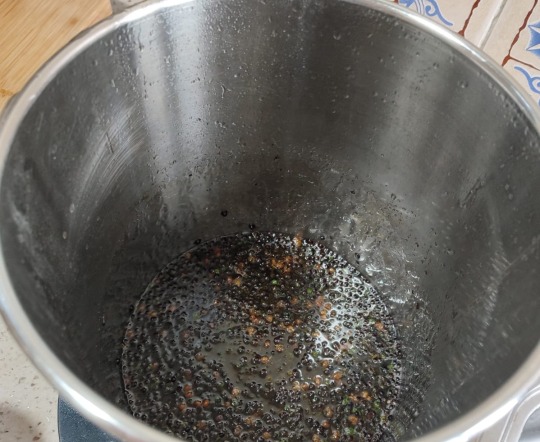
the boiled huajiao had all turned black - those paler bits are a handful of dried huajiao I decided to throw in on a whim, and the green specks are a few I reserved until just then.
Under the standard cold plate test, this did seem to have set, but I don't know how to tell if this was due to pectin in the huajiao, or just reducing a sugar syrup enough.
Here's some in a little bowl, so you have a better idea what it looked like
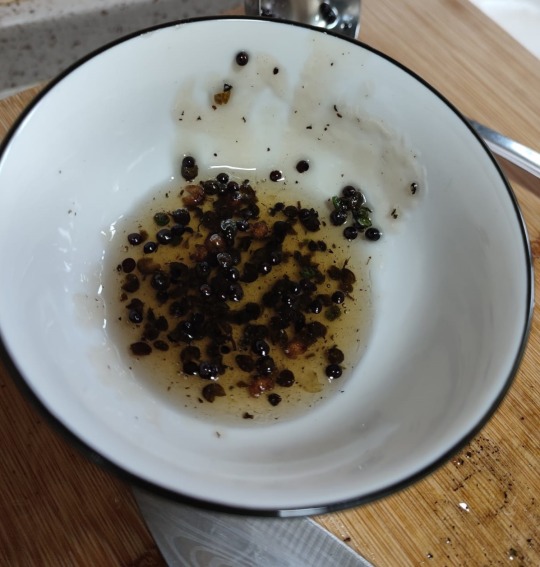
appetizing, huh?
How does it taste? Not bad, but surprisingly bland. The liquid itself has a fairly mild huajiao flavor - the (crunchy but very much edible) chunks are much stronger.
I like it: I finished off that sample above with a slice of bread, but you could have achieved almost the same effect by adding some dried huajiao powder to a sugar syrup (and if you're familiar with certain sichuanese snacks, you know that's already a thing).
However: this could easily be much better - there were clearly a lot of tasty volatile chemicals in there that I just cooked to death. If I'd started with significantly less water, and boiled this for the absolute minimum time necessary, the results could have been much more interesting.
...except maybe it wouldn't have set. If anyone wants to try this themselves, I suggest cheating a little and taking the membranes from an actual citrus fruit (pomelo?) for the pectin - and maybe the flesh too, huajiao has no juice, and so no acid, that's probably not helping the taste.
5 notes
·
View notes
Text
Citrus Pectin Market Genesis: From Orchard to Plate, Crafting Culinary Masterpieces

Citrus pectin is a rich source of dietary fiber extracted from citrus fruit peels. It is commonly used as a gelling agent and stabilizer in food and beverage products. Citrus pectin is used to make jams, jellies, fruit fillings, and fruit-based dairy products. It is also used as an emulsifier and thickening agent in cosmetics and pharmaceutical products.
The global citrus pectin market is estimated to be valued at US$ 580.6 Mn in 2023 and is expected to exhibit a CAGR of 6.6% over the forecast period 2023-2030, as highlighted in a new report published by Coherent Market Insights. Market Dynamics: The global citrus pectin market is witnessing high growth owing to its wide application in various industries such as food and beverage, pharmaceuticals, and cosmetics among others. One of the key drivers contributing to the market growth is the increasing demand for citrus pectin from the food processing industry. Citrus pectin is commonly used as a gelling agent and stabilizer in various food products such as jams, jellies, fruit filling, fruit-based dairy products, and powdered drink mixes. According to data by Food and Agriculture Organization of the United Nations, the global processed food market was valued at USD 2.2 trillion in 2020 and is expected to grow at a CAGR of 7% during 2021-2026. The growth of the processed food industry is fueling the demand for pectin as a gelling and stabilizing ingredient. Moreover, the growing health-consciousness and preference for natural ingredients is also boosting the utilization of citrus pectin in various industries. SWOT Analysis Strength: Citrus pectin has wide applications in various industries such as food & beverages, healthcare and personal care which drives its demand. It serves as a gelling agent, emulsifier and stabilizer. Citrus pectin is a source of dietary fiber that can help control cholesterol levels and maintain blood sugar levels. Weakness: The availability and price of raw materials required for citrus pectin production fluctuates continuously. Citrus crops are vulnerable to unfavorable weather conditions and diseases which affect the quality and yield of citrus fruits. Opportunity: Rising awareness about the health benefits of dietary fiber intake is fueling the demand for citrus pectin in functional foods. The growing food processing industry worldwide presents an opportunity for incorporating citrus pectin into various food products. Emerging economies offer ample opportunities for market expansion. Threats: The presence of substitutes such as guar gum, carrageenan and xanthan gum poses competition for citrus pectin. Strict regulations imposed on food additives could restrict the use of citrus pectin in certain applications. Key Takeaways The global citrus pectin market is expected to witness high growth at a CAGR of 6.6% during the forecast period of 2023-2030. Increased demand from the food & beverage industry is a major factor driving the growth of the market. Regional analysis: North America dominates the global citrus pectin market due to high awareness about health benefits of citrus pectin and expanding food processing industry in the region. The Asia Pacific region is anticipated to grow at the fastest pace in the coming years fueled by rising health consciousness and growing demand for processed foods in countries like China and India. Key players: Key players operating in the citrus pectin market are Herbstreith & Fox GmbH, Cargill Inc., CP Kelco, DSM Andre Pectin, Silvateam S.p.A, DuPont de Nemoursm Inc., Naturex A.G., and Krishna Pectins Pvt. Ltd. These players are focusing on new product development and mergers & acquisitions to strengthen their market position.
#Citrus Pectin Market Share#Citrus Pectin Market Growth#Citrus Pectin Market Demand#Citrus Pectin Market Trend#Citrus Pectin Market Analysis
0 notes
Text
SAURIAN OF THE DAY!



NAME:
Limau
SPECIES:
Yumkasarus
AGE:
Whelp
PERSONALITY:
Limau is a little Saurian with a sour attitude. He is very bitey, resulting in frequent time-outs and limited interaction with visitors.
For his age, Limau's cheek pouches are rather developed. As a result, he can swing in midair where other Saurians his age are still struggling to aim Flamegranate Pectin. On several occasions, this has led to escape attempts and his current enclosure being a large reinforced mesh-enclosed area. This is another reason his time outside of his room is limited.
FAVORITE FOODS:
The sourest of Quenepa Berries are his favorites, followed by Bulle Fruit-Quenepa Berry hybrids. Generally, anything citrus will satisfy Limau as a snack.
image was made by mod

2 notes
·
View notes